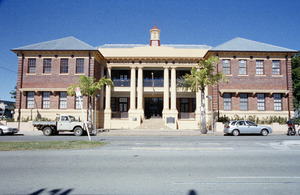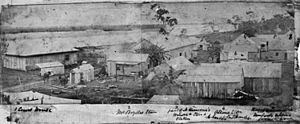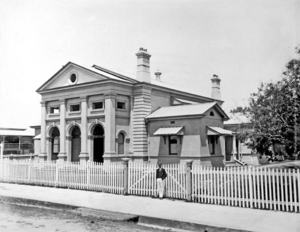Mackay Court House and Police Station facts for kids
Quick facts for kids Mackay Court House and Police Station |
|
|---|---|

Mackay Court House, 2005
|
|
| Location | 67 Victoria Street and 14 Brisbane Street, Mackay, Mackay Region, Queensland, Australia |
| Design period | 1870s - 1890s (late 19th century) |
| Built | 1886 - 1963 |
| Official name: Mackay Court House and Police Station, Mackay Court House | |
| Type | state heritage (built) |
| Designated | 21 October 1992 |
| Reference no. | 600673 |
| Significant period | 1880s, 1930s (historical) 1880s-1890s (fabric police station) 1930s (fabric court house) |
| Significant components | court house, police station, residential accommodation - police sergeant's house/quarters, watch house |
| Lua error in Module:Location_map at line 420: attempt to index field 'wikibase' (a nil value). | |
The Mackay Court House and Police Station is a special place in Mackay, Australia. It holds important buildings like a courthouse and a police station. These buildings are found on Victoria Street and Brisbane Street.
They were built over many years, from 1886 to 1963. This site is also known as the Mackay Court House and the Mackay Police Station. It was added to the Queensland Heritage Register on October 21, 1992. This means it's a protected historical site.
Contents
The Story of Mackay's Law and Order
This site has been used by police and judges in Mackay since the 1860s. Over time, new buildings were added or changed. Today, you can see the police station (which was once a court house from 1886). There is also the current court house, built in 1938. Two brick police homes from 1936-1937 are also on the property. Even a watch house and its keeper's home from the 1960s are part of this historic complex.
Early Days of Mackay
The town of Mackay is named after John Mackay. He explored the Pioneer River valley in 1860. The next year, he set up a farm there. In 1862, a small town started on the river's south side. By 1863, the town was mapped out, and the first land was sold.
Mackay became a port of entry for ships. A customs house opened to handle goods coming in. The town grew quickly as a port and a business hub. It served nearby farms and the growing sugar cane plantations. By late 1863, Mackay had two police officers.
How Police and Courts Began
In 1864, Queensland created a central police force. Before this, local judges managed police officers. This new system helped create a modern police force. The government faced a challenge: policing a huge area with few people and little money. Getting around was hard before good roads and railways.
To solve this, regional courts were set up. Judges or magistrates would visit these courts. They had police offices, places to stay, and lock-up cells all in one spot. In 1865, the police chief suggested combining police and court functions. This saved money and made things work better. Police officers rode horses, so stables and paddocks were also needed. Special police areas were set aside in major towns for all these needs.
In 1865, a police watch house was built in Mackay. It was at the northern end of the current site. A Police Magistrate was also appointed for the area. In 1872, a simple timber court house was built. It had a shingled roof. It was near the Customs House, not the police buildings. It was too small from the start.
A new court house was built in 1873, south of the lock-up. It was soon made bigger. This showed how fast the area was growing. A police station was built in 1878-1879. It included cells and barracks for officers.
Building a Grand Court House
The 1880s were a time of growth in Queensland. More people meant more police and court cases. New police and court buildings were built quickly. It was even hard to find enough skilled builders. The sugar industry was booming, and Mackay was a key center. Many new court houses were built in places like Mackay. In 1884, plans for a new court house were made. This followed new police stables and lock-up keeper's homes.
The new court house was designed by John James Clark. He was the Queensland Colonial Architect at the time. Clark was a famous architect from England. He designed important public buildings in Melbourne and Sydney. He became Queensland Colonial Architect in 1883.
Clark designed courthouses in Charters Towers, Rockhampton, and Warwick. The Mackay court house was also his design. These buildings were in the classical revival style. This style looked strong and important. It was perfect for public buildings like a court house. The court house opened on May 27, 1886. The first Supreme Court hearing was held there on June 15, 1886.
Growth and New Buildings in the 1930s
Even after a huge cyclone in 1918, Mackay grew a lot. Its population doubled between 1920 and 1940. This was because a railway connection in 1924 helped sugar, dairy, and tourism. The growth was supported by William Forgan Smith, a local leader and Premier of Queensland. He helped improve the town and harbor.
During the Depression years, many people lost their jobs. The government started big building projects to help. New police homes were designed in 1935. The inspector's home was built in 1936. The watch house keeper's home was built in 1937. These brick homes were very modern for Mackay. They were also better quality than older police housing. This showed how important Mackay was and how well it was doing.
The next big step was building a new, grand court house. The old one was too small. Andrew Baxter Leven was the Queensland Government Architect then. Leven designed many public buildings in the Georgian Revival style. The Mackay Court House is one of his grandest designs. It has beautiful wood panels inside. The court also had offices for other government groups. Premier Forgan Smith laid the first stone on March 31, 1938. The new court house faced Victoria Street. It became an impressive building on the main street.
After the new court house opened, the old one became the police station. It was changed in 1940-1941. They added to the back and built an upper floor. This provided more space for police and a recreation room.
Modern Additions
In 1961, plans were made for a new cell block. Architect Colin Tesch designed it. The new watch house was built in 1962-1963. It cost about £35,140. It was designed in the International Modernist style. This style was popular in Europe earlier. This building was part of a wave of new construction after World War II. A new home for the watch house keeper was also built next to the existing one.
In 1989, there was a plan to tear down the old police station. But the people of Mackay wanted to keep it. So, it was fixed up in 1990-1991. The 1938 Court House was also refurbished. A large new police building was built on the site. It includes a watch house. The old watch house is now mostly used for storage.
What the Buildings Look Like
The court house and police complex is in the center of Mackay. It is on the corner of Victoria and Brisbane Streets.
Police Station (Old Court House)
The Police Station used to be the Court House. It is a classical revival building. It is made of brick covered with plaster. The plaster is shaped to look like stone. Most of the building has two floors. The roof is made of corrugated sheets.
The front entrance has an arched Tuscan order portico. This means it has a covered walkway with three arches. Square columns go up two stories to a triangular top part called a pediment. This pediment has a round vent in the middle. Three square windows are above the arches. Single-story wings are on each side of the entrance. They also have arched windows, now filled with glass louvres. Sun hoods on metal brackets shade the windows. Inside, the old courtroom is now offices.
Court House
The court house is a two-story building. It is in the Georgian Revival style. It is made of brick with plaster details. It has two sloped roof sections. These flank a wall with a Tuscan order colonnade. This means it has a row of paired columns. The back also has a two-story porch with columns.
The main roof is high and sloped. It has a small spire called a Flèche in the center. The Brisbane Street side has a triangular top part with a round vent. The building has many-paned windows. Sun hoods shade the lower floor windows. Inside, the entry and stair halls are well-kept. They are covered with shiny silky oak wood panels. The floor is made of colorful terrazzo.
Police Residences
The police residences are two brick bungalows. They are easy to see from Brisbane Street. They have sloped roofs. Each house has a front room that sticks out. This room has a bay window under a strong triangular top. These triangular shapes look like the pediment on the police station.
The front door is on a small porch with timber railings. Low timber steps lead up to it. The windows are paired casement windows. The houses are similar but not exactly the same. Their inside layouts are different. This was probably to suit the first people who lived there. The insides still look like they did when built. Both houses have wooden floors, plastered walls, and decorated ceilings.
Watch House
The watch house has two stories. It is rectangular and made of brick and patterned concrete blocks. It has a balanced but not perfectly even design. The main floor is raised, with car parking underneath. Both levels are now mostly used for storage.
The northern part is made of brick. It has deep, square windows with bold frames. This part holds a staircase, records, and storage. It connects to the main building by a lower section. This section has a textured wall and narrow windows. The main building is covered by patterned Besser blocks. The inside is very plain and practical.
The watch keeper's residence is an addition to the 1935 keeper's residence. It looks similar on the outside. But the inside is more modern. It has an open plan layout.
Why This Place is Important
The Mackay Court House and Police Station was listed on the Queensland Heritage Register on October 21, 1992. It meets several important standards.
Showing History's Story
This complex shows how Queensland's history has changed. It has a court and police station that grew over time. This happened as laws, people, and how justice was managed changed. The buildings show how the legal system was set up and run. The quality of the buildings also shows how important Mackay was. It was a key regional center in the 1880s when sugar was booming. It was also the fastest-growing town in Queensland between the World Wars. The buildings from the 1930s are great examples of projects built to help people find jobs during the Depression.
These buildings were also important works by government architects JJ Clark and AB Leven. They were both skilled architects. They helped shape architecture in Queensland.
Learning from the Past
The buildings on this site and how they relate to each other are important. Their design, materials, and the many records about them can teach us a lot. They help us understand both the city of Mackay and the laws that served it.
Great Examples of Public Buildings
The two court houses are excellent examples of public buildings from their time. They show the high quality work done by the government architect's office.
Beautiful and Important to See
These are large and well-placed public buildings. They are architecturally beautiful. They add a lot to the look and feel of Mackay.
Special Connection to the Community
The court house and police complex has a long history with the people of Mackay. It has been the main place for justice in the area for a very long time.
Images for kids




